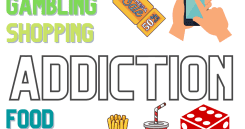The holiday season, with its rush of decorating, parties and gift exchanges, is a common and potentially harmful trigger for people struggling to manage a compulsive shopping addiction.
For sufferers of oniomania—the psychological term for compulsive spending—the holidays present the riskiest time of the year for those suffering or in recovery.
Black Friday, was traditionally the kick-off to shopping season – a literal nirvana for people with a shopping addiction. This year, more stores opened their doors on Thanksgiving night, causing an early start to Black Friday spending. As if that weren’t bad enough, the Internet’s one-day shopping extravaganza, appropriately dubbed Cyber-Monday, has morphed into Cyber-Week. For shopping addicts, the temptations can seem endless. Bonny Forrest, a San Diego psychologist, says the euphoria of a money-saving deal or even buying presents for loved ones, is closely aligned with the feeling that people with substance use disorder experience with alcohol or drugs.
Most retailers depend on the winter holidays to generate the majority of their profits for the year, so incentives for consumers to buy and buy and buy are everywhere. There are so many bargains and special deals to be had that a season that has traditionally been about spending money on other people has started to become about making major home purchases, such as appliances, for ourselves.
For sufferers of oniomania—the psychological term for compulsive spending—the holidays present a particular challenge.
Signs of Shopping Addiction
Characteristics of shopping addiction include frequent shopping binges, over-buying for themselves and others (which can eventually turn into a hoarding problem) or constantly trolling online for “deals” on products they simply don’t need.
The compulsive spending behavior generally has a long-standing history before the addiction is formally recognized. Most compulsive spenders are exposed due to the financial burden a shopping addiction creates.
Similar to drug addiction, the longer compulsive shopping addiction goes on, the more the person’s brain becomes rewired to create an excessive release of endorphins – the “feel-good” chemical. People then experience a compulsion to shop, instigating a never-ending quest to feel that pleasure state again and again.

Don’t let your addictive disorder dictate the rest of your life. Call Hawaii Island Recovery for help overcoming your symptoms today.
More infoConsequences Of Shopping Addiction
A variety of negative consequences can occur as a result of compulsive buying disorder.
Financial consequences are the most obvious—compulsive buyers can rack up significant debt or run through their savings. Some may get second jobs in an attempt to counteract or conceal the results of their compulsive shopping.
Money is a primary source of conflict between married couples and long-term romantic partners, and it plays a role in many divorce cases. The financial irresponsibility that accompanies CBD and the conflict, economic stress and loss of trust that often result can be catastrophic for relationships.
Additionally, like other addictions, CBD makes individuals feel out of control and uncomfortably dependent on certain behavior in order to feel normal or happy. CBD can become so intense and overwhelming that compulsive buyers have emotional blackouts after which they do not remember the purchases they have made.
Tips for Healthy Holiday Shopping
If you or a loved one shows signs of compulsive shopping addiction, here are some tips to make it through the holiday buying season: Avoid online shopping, period. Block sites if you need to.
Practice a 24-hour rule: No purchase can be made inside of a 24-hour “thinking” period.
Give your credit cards to a trusted friend, keeping only a debit card for
daily necessities.
Find an alternative to a shopping expedition – make a plan to volunteer during the holidays or stay home and bake cookies for your neighbors.
If you must go shopping, take a buddy with you and give that person permission to question your purchases
FAQ: Oniomania, AKA Compulsive Buying Disorder
Compulsive buying disorder is common and widespread and is best classified as a disorder of impulse control. Compulsive buying disorder typically has an onset during the late teens/the early twenties and is nearly always chronic.
Developmental, neurobiological, and cultural factors have been proposed as factors in the development of compulsive buying disorder. Compulsive buying disorder is associated with mood, anxiety, substance use, eating, and impulse-control disorders.
There is no standard treatment for compulsive buying disorder, but cognitive-behavioral group models seem promising, and psychopharmacologic treatments are being studied.
How Hawaii Island Recovery treats shopping addiction?
 Hawaii Island Recovery
Hawaii Island Recovery 










